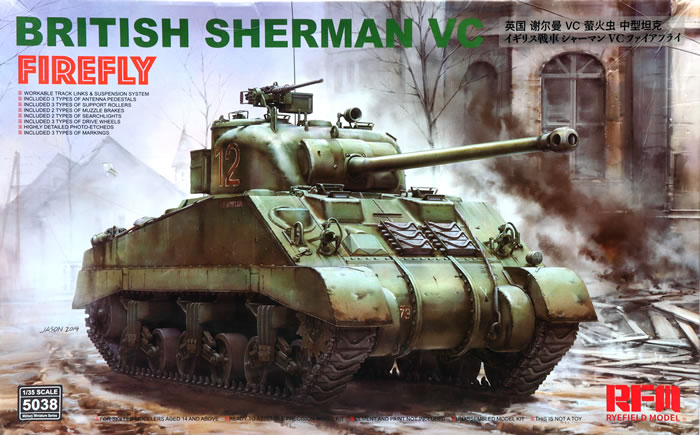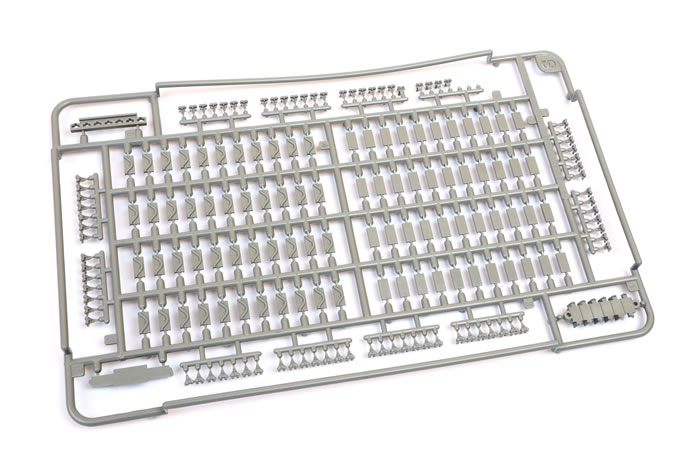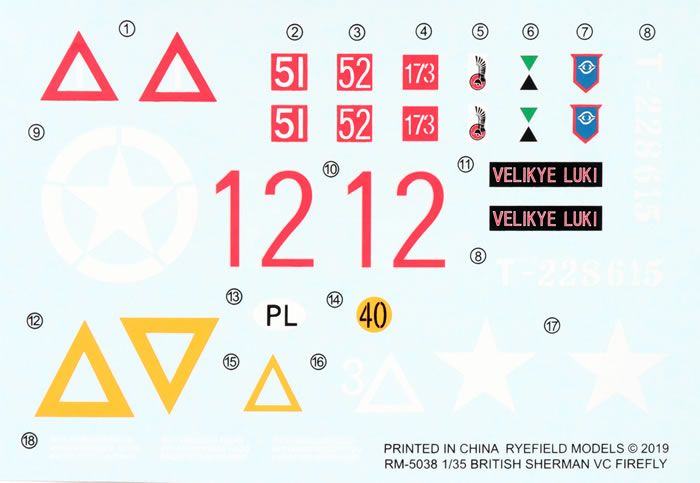
Sherman VC Firefly

Rye Field Models, 1/35 scale
Reviewed by Al Bowie
| Stock Number and Description |
Rye Field Models Kit No. RM-5038 - Sherman VC Firefly |
| Scale: |
1/35 |
| Media and Contents: |
See details below. |
| Price: |
TBA |
| Review Type: |
First Look |
| Advantages: |
Accurate; excellent level of detail; convincing surface textures. |
| Disadvantages: |
|
| Recommendation: |
I would highly recommend this as the best Firefly currently available in any scale and I hope that RFM offer M4A4/Sherman V variants and an interior variant as a follow on. Well done RFM on a superb offering. . |

Background
Due to the perceived threat from heavy German armour and the arrival of the Tiger on the battlefield, the British immediately undertook to fit their new 17 pdr anti-tank gun in a tank.
Originally it was envisaged that the Cromwell based Challenger would be that vehicle, however there were problems with the turret and after it was proved that it could be fitted to the Sherman a program was setup to manufacture 17 pdr armed Shermans, now known as Fireflies.
The British settled on the Sherman V (M4A4) and the Sherman 1 (M4) for conversion and more than 2,000 were converted between late 1943 and early 1945.
The Firefly’s baptism of fire was Normandy where the Sherman V based Firefly designated VC saw extensive use and was the sole variant for the first month of fighting when the Sherman Ic began to appear. They were deployed across all British, Canadian and Polish the Armoured Brigades and Divisions excluding the Churchill equipped Tank Brigades, whose role was infantry support.
The Firefly was an immediate success giving the British tankies the ability to take on and defeat the heavier German tanks such as the Tiger and Panther which faced them in quantity at long range. They came as a great shock to the Germans who quickly learnt to prioritise targeting this new threat.
FirstLook
Rye Field Models has followed on from their excellent Sherman M4A3E8 with a brand new and highly detailed kit of the Sherman VC Firefly.
The kit depicts the initial VC with the earlier turret with pistol port and offers three decal options for vehicles that fought in Normandy.
This is not the first Firefly kit to market with earlier kits by DML from the 1990s and TASCA (Now ASUKA) from the early 2000s.
When the TASCA kit was released it was hailed as a superbly accurate, detailed and buildable kit. In fact many questioned whether it was the Perfect Sherman kit. It was thought it was hard to improve on and I have to state here in almost every way this new kit does just that which is very high praise indeed.

So, for the Shermaholic with a ton of TASCA/ASUKA Fireflies in the stash, is this kit worth replacing them? The answer is yes. This is like a refined version of that kit with all the detail options missed originally missed now done. It is a truly stunning and complete kit offering full detail such as rotatable periscopes and Individual track links plus a spring-based suspension replacing the foam compression of the TASCA ones.

One cannot open this box and look at the kit without comparison to the TASCA kit. It is eerily similar in construction but does have a few minor differences particularly hull construction.
Construction starts with the multi-part lower hull and transmission/final drives. Both the earlier horizontal UK towing hitch and the vertical post type hitch are included as options, however the modeller is left to make up their own mind on which (if any) to fit.
Photo-etch is used to detail many of the parts here such as the mountings and the smoke dischargers. Fortunately, the approach to photo-etch is good and does not require ridiculous bending skills being used sensibly where it will enhance an assembly rather than replacing whole assemblies.

The idler wheels are multipart and allow the lip however you will have a seam down the centre join to (easily) remove.
Three different drive sprocket assembly types are included, again leaving the modeller to decide which one to use. My references almost exclusively indicate Assy 5 (parts J2 and J10) as being fitted to VC Fireflies. The exhausts and the grille are very well done and detailed, note the comments about fitting of track guards in the inset box in Assembly 8 of Step 4.
The bogies come next and are well detailed and workable like the real thing. Metal springs are provided. The three bolts on the bottom of the bogie are incorrect and should be more compact bolt heads typical of the bogies Chrysler was using. Easy to fix - just cut it down to the bolt head.
No bolt holes are in either bogie face however they have included the spring tensioning bolts on the top of the bogie. The Skids are provided with bolt heads that have to be shaved off sprue J and glued on.
Step 6 is the tracks and a very clever and useful jig is provided which will make assembly a lot easier than the useful for individual Sherman tracks. T 62 are provided which is correct for most VC Fireflies. The upper hull is then constructed and it is very detailed with all hatch details provided along with casting details etc. Photo-etched light guards are provided along with a very familiar jig to bend them. Note carefully any holes that have to opened up in the hull. The engine deck details are again excellent with casting marks etc and optional gun crutch stowage allow – again we see no indication of which one to use.

The rear stowage box is well detailed with an openable lid and PE clasps. The kit has Houseboat fittings for the collapsible canvas disguise (never used in action on a Firefly) but the fittings were seen on the early production Fireflies in Normandy. Full sand shields are supplied with PE detailing and joiners or the option of PE strip where not fitted, it is a very complete set.
We now move to the turret which is exceptionally detailed and missing none of the small details of the original on the exterior. The Gun barrel/tube is one piece with a three-piece muzzle break including a photo-etched representation of the rifling, which needs to be rolled to fit. No real interior detailing is included in the turret excepting periscopes, the smoke mortar and the co-ax .30 cal. No gun breech is included despite the fact it would be clearly visible through the large hatches. Hatches can be displayed open or closed with full details on the interior and a rotatable periscope. The kit provides a turret mounted .50 cal which, despite a lot of popular thought, were carried but not universally. At least one of the marking options was photographed in Normandy with it. The .50 cal is very nice and very similar to the excellent TASCA one. It has the larger 100 round ammo box rarely seen on British tank 50 cal.
The radio box extension has only one type of box lid with the three, square shaped access plates. A very nice blanket box is provided. The cupola is very detailed with fully rotatable periscopes, hatch details and latches and gun mount details. Alternate turret spot lamps are provided, a full turret ring is provided which is useful for conversion work or displaying a wreck. A string tow cable is provided but looks to be under diameter to me.
The kit offers three sets of decals for two British and one Polish example all of which saw action in Normandy and NWE.
- “Velkye Luki” 3 Tp A Sqn Northamptonshire Yeomanry (Involved in Wittmans Demise) Jul 1944
- 1 TP A Company 2 Grenadier Gds (Armoured) of 5 Guards Armoured Brigade Sept 1944
- 1 Sqn 2 Armd Regiment Polish 1st Armoured Division UK Spring 1944 (although this vehicle is photographed in the Falaise battles in Aug 1944)

Decals appear to be complete and accurate in good register.
Conclusion
In summary, this is an excellent kit that takes all the little things missing from the TASCA VC and adds them to give a very complete product. I did note the fit which, while it is very good, is not the precision fit of the TASCA kit if that bothers you.
I would highly recommend this as the best Firefly currently available in any scale and I hope that RFM offer M4A4/Sherman V variants and an interior variant as a follow on.
Well done RFM on a superb offering.
Purchased by reviewer.
Text by Al Bowie
Images by Brett Green
Page Created 11 July, 2020
Page Last Updated
11 July, 2020
|